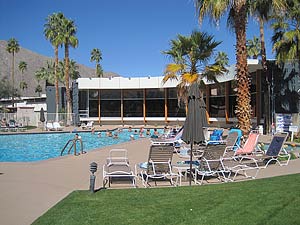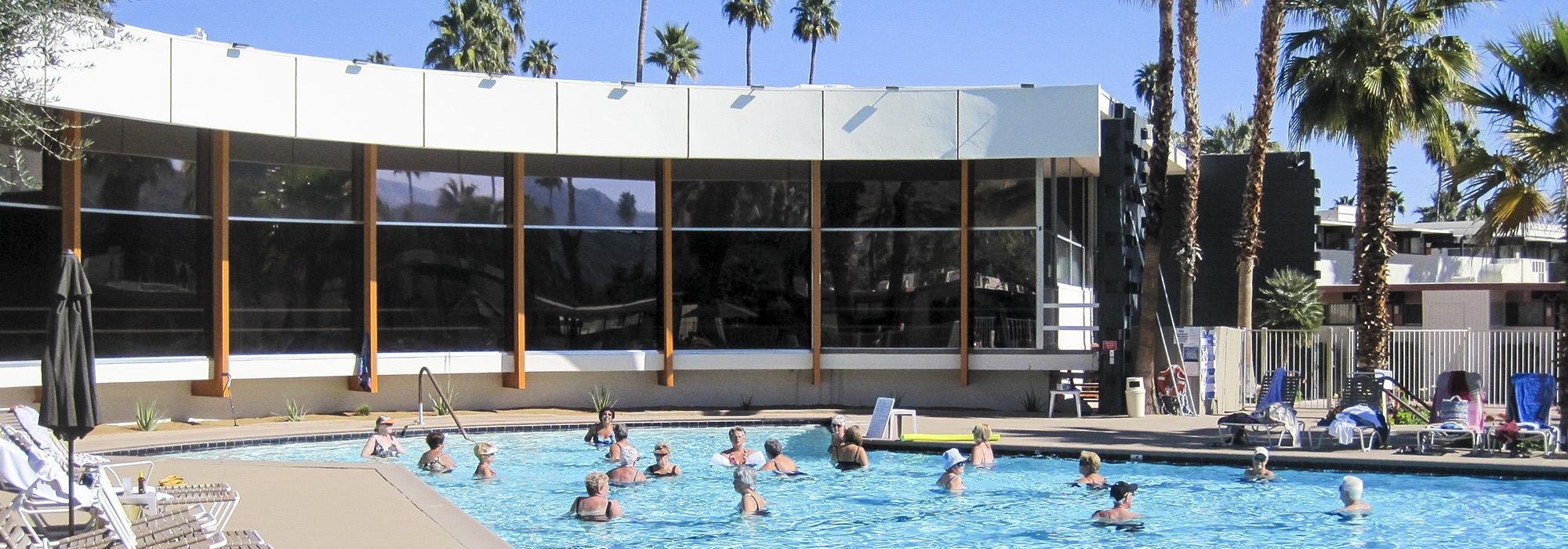The Eckbo Incident
One of my favorite Western flicks is William Wellman’s The Oxbow Incident. In this 1943 film, two drifters pass through a western town and what transpires over the ensuing 75 minutes is serious trouble-making . . . in this case a mixture of heavy drinking, lynching and gun fighting. The film starring Henry Fonda was not considered a success during its initial release, but according to Internet Movie Database, it is today “safely ranked as one of classic cinema’s greatest treasures.”
Although my two trips west to California over the past month did not include such shenanigans, visits to two classic Garrett Eckbo landscapes – one in Palm Springs and the other in Pasadena raised more questions than answers. I guess one can say that this blog aspires to rustle up some trouble by asking the design and historic preservation communities: where are we and what are we doing?

Ocotillo Lodge, Palm Springs, CA
The two Modernist designs in question are the Ocotillo Lodge on Canyon Drive in Palm Springs, a compact, 7-acre residential resort built in 1956, which today welcomes vacation rental condos; and the Ambassador College campus in Pasadena founded in 1947. Today the Ocotillo Lodge with its key-hole shaped swimming pool is still much beloved by its residents and has only been subjected to very minor alterations (the lobby and its entrance have been altered slightly, a fence has been installed around the pool and paint colors have changed), while significant elements of Eckbo’s design for the institutional landscape of Ambassador College that he described as “large old gardens of individual character .. merged, connected, integrated, and redeveloped to campus scale and character” face an uncertain future.
At Ambassador, Eckbo revised the Daniel, Mann, Johnson and Mendenhall (DMJM) plan of 1963. The following year, the first fruits of these efforts were published as an 11-page example in his book, Urban Landscape Design (p. 68-79). The college closed in the 1980s, and today, the Fine Arts Building and Science Hall, built in 1966 and designed by architect Peter J. Holdstock with an Eckbo landscape design, are slated for demolition. As I visited Ambassador with architectural historian and TCLF Board Member, Meredith Bzdak, PhD, I was quick to note her response, and recorded her words: “I was instantly struck by the way in which Holdstock and Eckbo created such a bold and rich environment within an otherwise traditional educational setting. The playful physical forms – so typical for the mid-20th century and yet somehow so specific to the experimental nature of southern California – set within the superbly integrated courtyard fountains, graphic paving, and tropical vegetation – were all breathtaking. For me, the thought that this cultural landscape with its multiple, lively juxtapositions of material and form might cease to exist is nothing short of tragic.”
In that moment we questioned the role that historians, preservation and design professionals can play? We wondered where was the LA Conservancy, The National Trust’s Modernism + Recent Past Initiative, the Southern California Chapter of the ASLA, DOCOMOMO and graduate-level historic preservation and design programs in the region?
What is interesting about this pair of projects is that they both represent rare, surviving examples of Eckbo’s early work, yet only Ocotillo, the project not threatened with significant change, was documented for the Historic American Landscapes Survey (HALS) by landscape architect J.C. Miller last September, while those sections of Ambassador College that are truly threatened, remain undocumented and vulnerable to demolition.
Perhaps the solution can be found in Eckbo’s own plea that “collaboration among members of various design professions is demanded by the increasing scale and complexity of landscape problems.” (Urban Landscape Design, p. 5) In considering these two National Register eligible projects, it is clear that there is not a larger strategy in place to insure that this legacy is, at the very minimum, documented, and ideally preserved and rehabilitated for future generations. The Cultural Landscape Foundation would like to help our state and local partners in this effort. Let’s hear from you.



